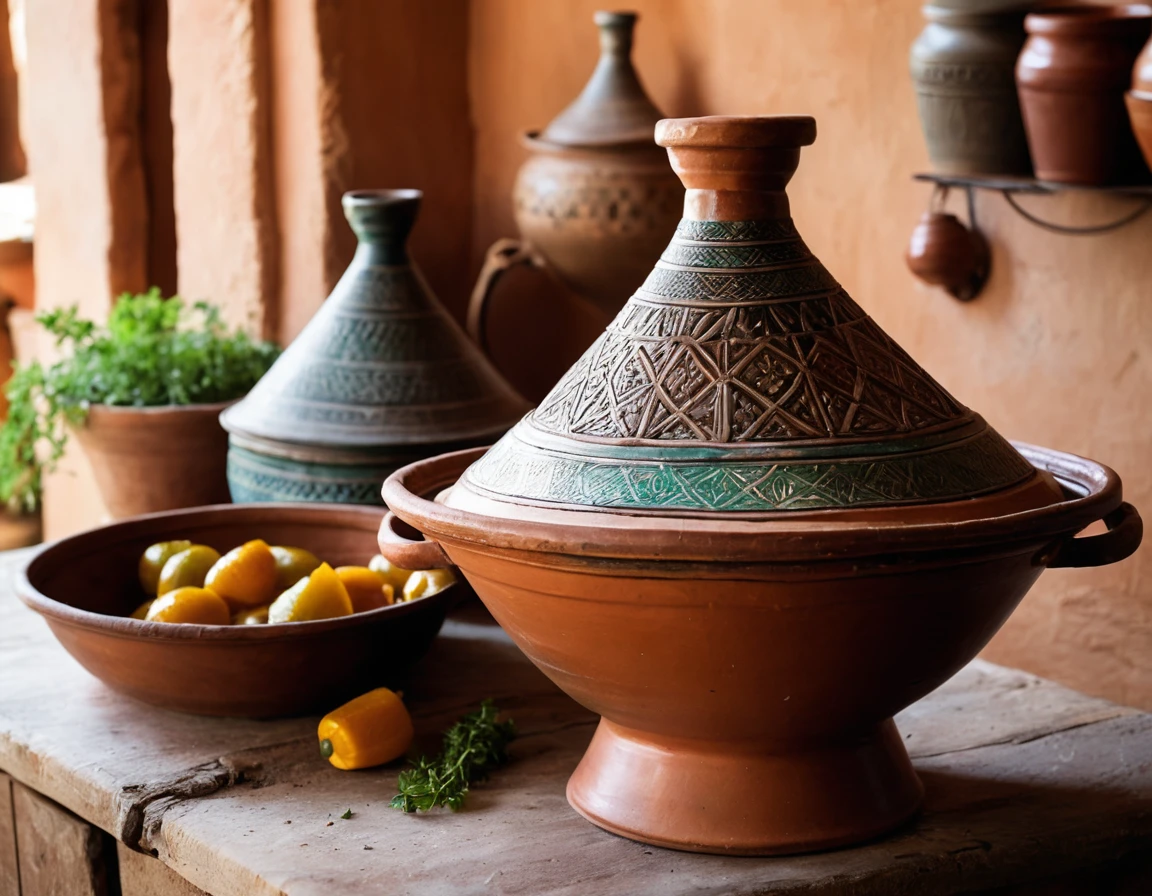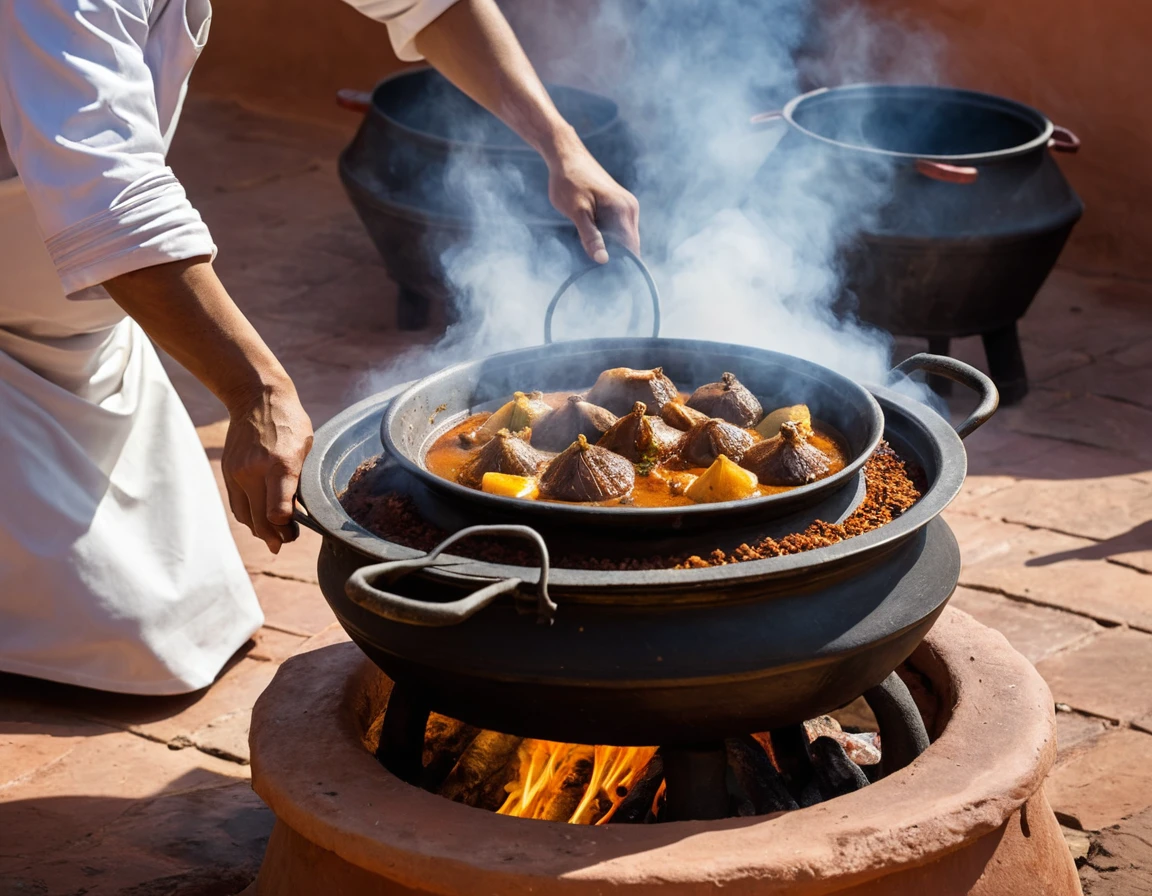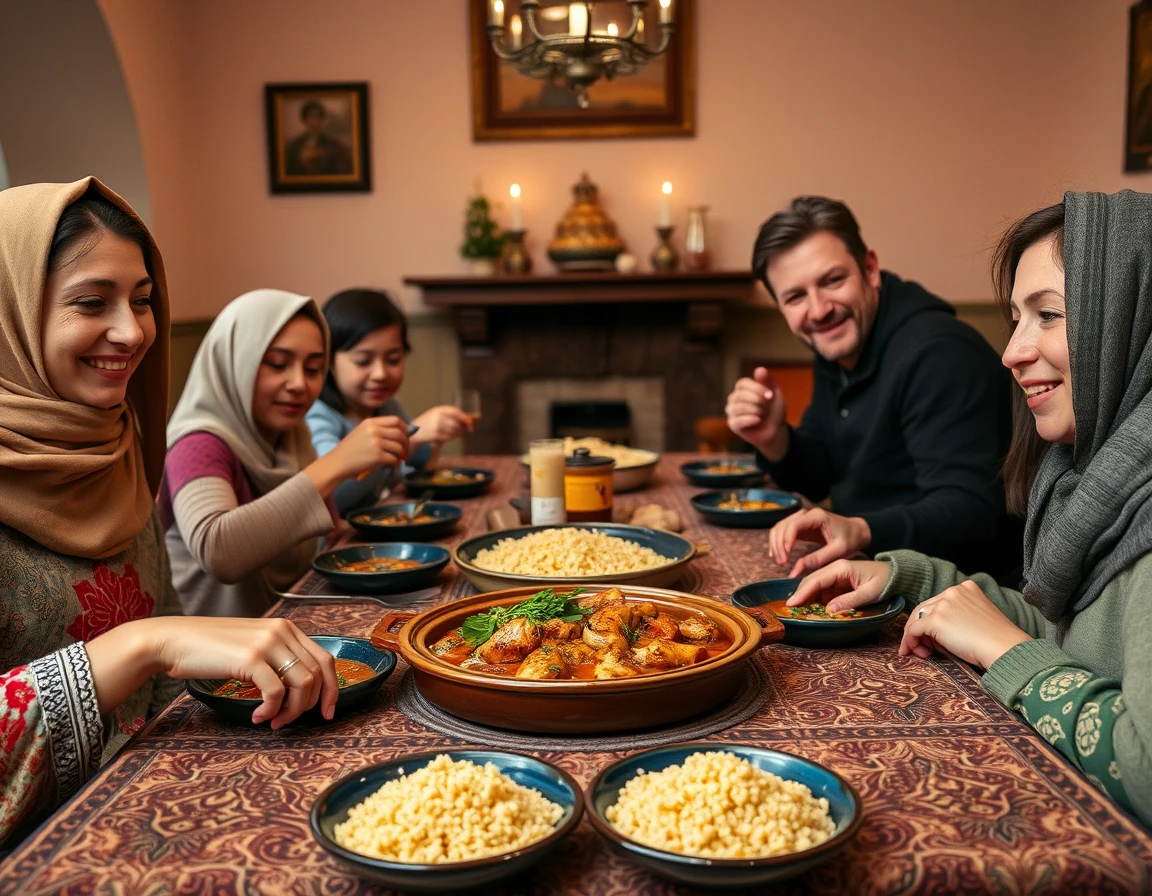The Rich History of Moroccan Cuisine
Moroccan cuisine is a melting pot of cultural influences, reflecting the country’s historical interactions with various civilizations. The indigenous Berbers initially laid the foundation with their simple, hearty dishes. Arab invasions in the 7th century introduced a variety of spices like cinnamon, cumin, and saffron, significantly transforming the culinary landscape. Moorish exiles from Spain brought with them olives and citrus fruits, adding new dimensions to the cuisine. The French colonial period further enriched Moroccan cuisine, introducing techniques and dishes that blended seamlessly with traditional practices. This rich tapestry of influences has given Moroccan cuisine its distinctive character, celebrated worldwide for its bold flavors and aromatic spices.

Key Ingredients in Moroccan Cooking
Moroccan dishes often revolve around key ingredients such as preserved lemons, olives, dates, and a range of spices including cumin, coriander, saffron, and turmeric. These ingredients contribute to the distinctive taste and aroma of Moroccan cuisine. For example, preserved lemons add a tangy, umami flavor that is essential in many Moroccan stews and tagines. The use of fresh herbs such as cilantro and parsley further enhances the freshness and vibrancy of the dishes. Moroccan cuisine also heavily relies on the use of olive oil, which imparts a rich, fruity flavor to many dishes. Another essential ingredient is harissa, a spicy chili paste that adds a fiery kick to Moroccan meals.

Popular Moroccan Dishes
Moroccan cuisine is known for its diverse and flavorful dishes like couscous, pastilla, harira, and of course, tagine. Each dish has its own unique preparation method and combination of spices and ingredients, making Moroccan food both varied and exciting. Couscous, a staple dish, is often steamed and served with meat or vegetable stews. Pastilla, a sweet and savory pie, combines flaky pastry with a rich filling of pigeon or chicken, almonds, and spices. Harira, a traditional soup, is commonly eaten to break the fast during Ramadan. Tagine, a slow-cooked stew, can be made with various meats, vegetables, and even fruits, offering endless possibilities for flavor combinations.

What is a Tagine?
A tagine is both a dish and the name of the conical clay pot in which it is cooked. The unique shape of the tagine pot allows steam to circulate during cooking, ensuring that the food stays moist and flavorful. Traditionally, tagines are slow-cooked over charcoal, allowing the flavors to meld together over time. The dish itself typically includes meat, vegetables, and a variety of spices and is characterized by its rich, complex flavors and tender texture. Tagines are often served with couscous or bread to soak up the delicious sauce. The cooking process creates a harmonious blend of spices and ingredients, making each bite a culinary delight.

Traditional Tagine Cooking Methods
Traditional tagine cooking involves a slow-cooking process that allows the ingredients to simmer and develop deep, complex flavors. This method usually takes several hours and is done over a low heat, often using a charcoal brazier. The slow-cooking method not only infuses the dish with the flavors of the spices and ingredients but also ensures that the meat becomes incredibly tender. The tagine pot’s lid helps retain moisture, making the dish both succulent and rich in flavor. This method is especially effective for tougher cuts of meat, which become melt-in-your-mouth tender after slow cooking. The gentle cooking process also preserves the integrity of delicate vegetables and fruits used in the dish.

Modern Adaptations of Tagine Cooking
Moroccan dishes often revolve around key ingredients such as preserved lemons, olives, dates, and a range of spices including cumin, coriander, saffron, and turmeric. These ingredients contribute to the distinctive taste and aroma of Moroccan cuisine. For example, preserved lemons add a tangy, umami flavor that is essential in many Moroccan stews and tagines. The use of fresh herbs such as cilantro and parsley further enhances the freshness and vibrancy of the dishes. Moroccan cuisine also heavily relies on the use of olive oil, which imparts a rich, fruity flavor to many dishes. Another essential ingredient is harissa, a spicy chili paste that adds a fiery kick to Moroccan meals.

Moroccan Spiced Chicken Tagine with Couscous
A hearty and flavorful Moroccan dish featuring tender chicken cooked with aromatic spices, dried fruits, and nuts, served over fluffy couscous.

Preparation Time
20 minutes
Cooking Time
1 hour 30 minutes
Servings
4-6 servings
Total Time
1 hour 50 minutes
Equipment
- Tagine or heavy-bottomed pot
- Cutting board and knife
- Measuring cups and spoons
- Mixing bowls
- Wooden spoon
- Serving platter
Ingredients
- Chicken thighs
- Olive oil
- Onions
- Garlic
- Ground cumin
- Ground coriander
- Cinnamon
- Ginger
- Saffron
- Chicken broth
- Chickpeas
- Dried apricots
- Pitted green olives
- Couscous
- Salt and pepper
Recipe Special Notes
- Tips for Blooming Saffron
- Soak saffron threads in warm water or stock before adding them to the dish to release their full flavor and color. This step is crucial for infusing the tagine with the distinct, rich aroma and golden hue of saffron.
- Substitutes for Traditional Ingredients
- If certain ingredients like preserved lemons or specific spices are not available, substitutes such as fresh lemons, lemon zest, or a combination of other spices can be used to achieve a similar flavor profile.
- Serving Suggestions
- Serve the chicken tagine with couscous and a side of fresh Moroccan salad, or with traditional Moroccan bread to soak up the flavorful sauce. Finish with a sprinkle of fresh cilantro or parsley for an added burst of freshness.
Step-by-Step Recipe Instructions
- Preparing the Chicken
- Start by applying a generous seasoning of salt and pepper to the chicken thighs. In a tagine or heavy-bottomed pot, heat the olive oil over medium heat and sear the chicken until browned on all sides. Remove the chicken and set aside.
- Sautéing the Aromatics
- In the same pot, sauté the chopped onions and minced garlic until they turn soft and translucent. This helps in building a rich flavor base for the tagine.
- Adding the Spices
- Stir in the ground cumin, ground coriander, cinnamon, and ginger, ensuring that the spices evenly coat the onions and garlic. Let them toast for a minute to release their fragrant oils.
- Simmering the Tagine
- Place the browned chicken back into the pot along with chicken broth, chickpeas, dried apricots, and pitted green olives. Bring the mixture to a gentle simmer, cover, and cook on low heat for 1 hour and 30 minutes.
- Cooking the Couscous
- Follow the package instructions to prepare the couscous. Once cooked, fluff it up with a fork to ensure it is light and airy, ready to absorb the flavorful tagine sauce.
- Combining and Serving
- When the chicken is tender and the flavors have beautifully melded, serve the tagine over a bed of fluffy couscous. Top with chopped cilantro or parsley for a refreshing touch and enjoy the dish warm.
Moroccan Spiced Chicken Tagine with Couscous: A Culinary Journey
A delightful and authentic Moroccan dish that brings the flavors of the Maghreb to your table.

Positives
- Rich and complex flavors
- Hearty and satisfying
- Easy to prepare with simple ingredients
FAQs
- What is a Tagine?
- A tagine is a traditional North African clay pot used for slow-cooking stews and other dishes. It is also the name of the dish itself, characterized by its rich, aromatic flavors and tender ingredients.
- Can I use a different type of meat?
- Yes, different meats such as lamb, beef, or even fish can be used in place of chicken. Just make sure to adjust the cooking time to ensure the meat is thoroughly cooked and tender.
- What are some side dishes that pair well with this tagine?
- Traditional Moroccan side dishes that pair well with chicken tagine include couscous, Moroccan salad, and bread like khobz or batbout. These sides complement the rich flavors of the tagine.
- How can I store leftovers?
- For optimal freshness, store leftovers in an airtight container in the refrigerator for up to three days. When ready to eat, gently reheat on the stove or in the microwave, adding a splash of water or broth if necessary to restore moisture.

LSI and NLP Keywords
- Moroccan chicken tagine recipe
- Authentic Moroccan cuisine
- North African spices
- Traditional Moroccan dishes
- How to make chicken tagine
- Couscous recipes
- Moroccan cooking techniques
- Tagine cooking pot
- Middle Eastern flavors
- Chicken and couscous recipes
External Links
- Middle Eastern Recipes – “Moroccan Chicken Tagine with Couscous”
- Salima’s Kitchen – “How to Make Moroccan Chicken Tajine (Tagine)”
- RecipeTin Eats – “Chicken Tagine”
I hope you enjoy making and tasting this delightful Moroccan Spiced Chicken Tagine with Couscous!

